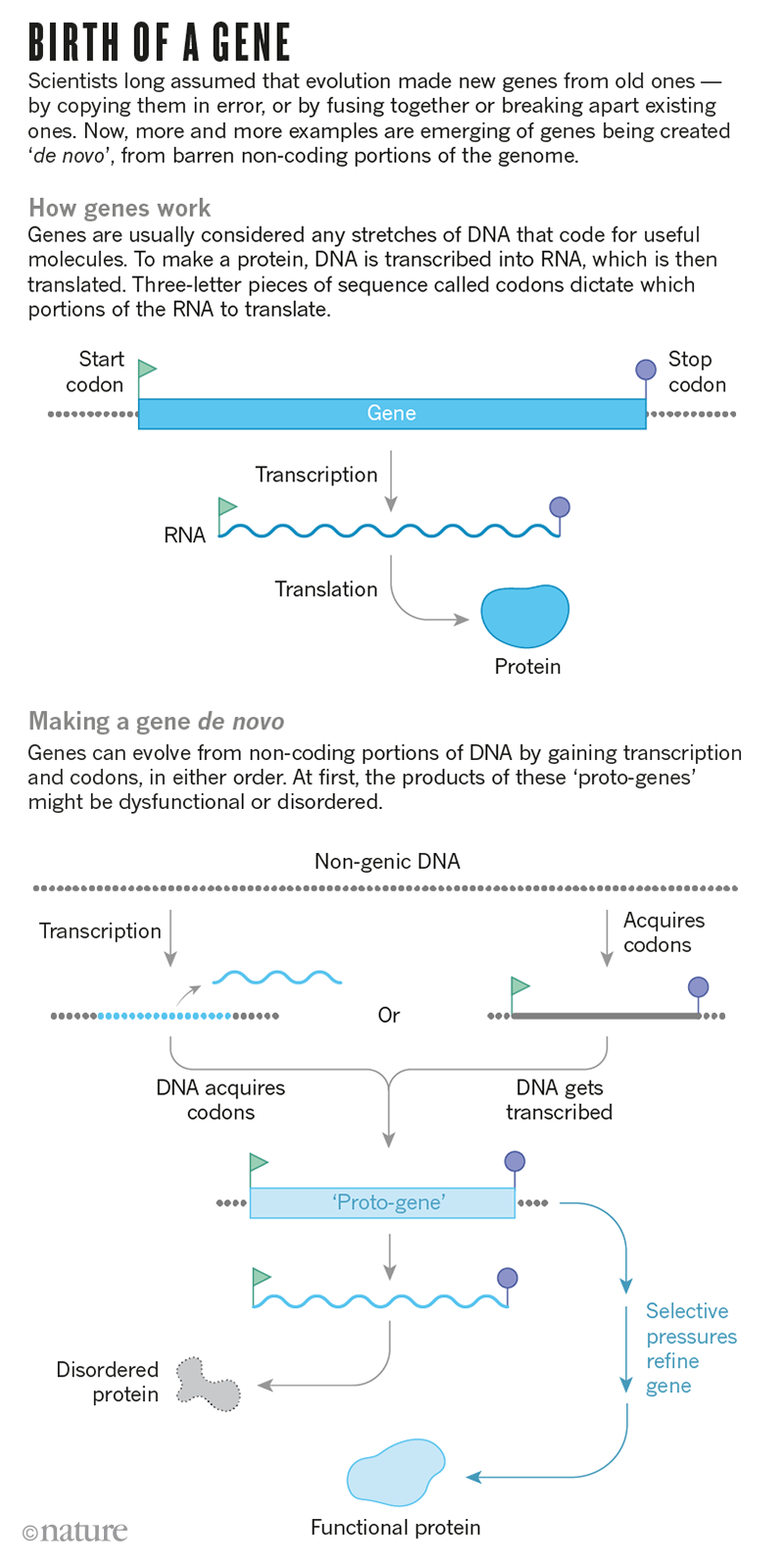Science
Related: About this forumHow evolution builds genes from scratch.
The news item I'll discuss in this post is this one: How evolution builds genes from scratch
I don't think I logged into Nature when I saw it, so I think it's open sourced.
A lot of my day to day work is involved in proteomics either directly or indirectly. I am therefore often required to think about protein isoforms, many of which arise from genetic differences in people and related organisms; there is little more fascinating than seeing those forms highly conserved throughout evolution in comparison to variable, and indeed, vestigial proteins and sequences.
A surprise of the discovery of automated gene sequencing that led to the result of the human genome sequence, as the subsequent gene mapping of many other species is how much "junk DNA" there is, some of which is artifacts of ancient viral infections in ancestors or ancestral organisms.
This news article suggests that new genes can sometimes arise from turning on "junk DNA."
Some excerpts:
PDF version
5-inch Arctic cod in hollows of ice floes in the Arctic Ocean
Some cod species have a newly minted gene involved in preventing freezing.Credit: Paul Nicklen/NG Image Collection
In the depths of winter, water temperatures in the ice-covered Arctic Ocean can sink below zero. That’s cold enough to freeze many fish, but the conditions don’t trouble the cod. A protein in its blood and tissues binds to tiny ice crystals and stops them from growing.
Where codfish got this talent was a puzzle that evolutionary biologist Helle Tessand Baalsrud wanted to solve. She and her team at the University of Oslo searched the genomes of the Atlantic cod (Gadus morhua) and several of its closest relatives, thinking they would track down the cousins of the antifreeze gene. None showed up. Baalsrud, who at the time was a new parent, worried that her lack of sleep was causing her to miss something obvious.
But then she stumbled on studies suggesting that genes do not always evolve from existing ones, as biologists long supposed. Instead, some are fashioned from desolate stretches of the genome that do not code for any functional molecules. When she looked back at the fish genomes, she saw hints this might be the case: the antifreeze protein — essential to the cod’s survival — had seemingly been built from scratch1.
The cod is in good company. In the past five years, researchers have found numerous signs of these newly minted ‘de novo’ genes in every lineage they have surveyed. These include model organisms such as fruit flies and mice, important crop plants and humans; some of the genes are expressed in brain and testicular tissue, others in various cancers...
...Back in the 1970s, geneticists saw evolution as a rather conservative process. When Susumu Ohno laid out the hypothesis that most genes evolved through duplication2, he wrote that “In a strict sense, nothing in evolution is created de novo. Each new gene must have arisen from an already existing gene.”
Gene duplication occurs when errors in the DNA-replication process produce multiple instances of a gene. Over generations, the versions accrue mutations and diverge, so that they eventually encode different molecules, each with their own function. Since the 1970s, researchers have found a raft of other examples of how evolution tinkers with genes — existing genes can be broken up or ‘laterally transferred’ between species. All these processes have something in common: their main ingredient is existing code from a well-oiled molecular machine...
...But genomes contain much more than just genes: in fact, only a few per cent of the human genome, for example, actually encodes genes. Alongside are substantial stretches of DNA — often labelled ‘junk DNA’ — that seem to lack any function. Some of these stretches share features with protein-coding genes without actually being genes themselves: for instance, they are littered with three-letter codons that could, in theory, tell the cell to translate the code into a protein.
It wasn’t until the twenty-first century that scientists began to see hints that non-coding sections of DNA could lead to new functional codes for proteins. As genetic sequencing advanced to the point that researchers could compare entire genomes of close relatives, they began to find evidence that genes could disappear rather quickly during evolution...
...Some of these genes-in-waiting, or what Carvunis and her colleagues called proto-genes, were more gene-like than others, with longer sequences and more of the instructions necessary for turning the DNA into proteins. The proto-genes could provide a fertile testing ground for evolution to convert non-coding material into true genes. “It’s like a beta launch,” suggests Aoife McLysaght, who works on molecular evolution at Trinity College Dublin...
The nice cartoon in the news article:

Interesting I think.
tblue37
(65,216 posts)Bayard
(22,005 posts)Wonder what this means for the future? Will species develop genes to deal with climate change?
Midnightwalk
(3,131 posts)Maybe this is the point but doesn’t this suggest that junk dna may he more of a junkyard. Genes that were useful at one point but stopped being useful and were turned off randomly by the deletion of codons.
Those now unused genes (now codon-less)
didn’t go anywhere but would have degraded over time. It would be fascinating to know how close the new protein is to an old use. In the cod example could that sequence have allowed for tolerance to cold multiple times in different species?
Or is it more like the codons are added more randomly say with half of old gene 1 and half of gene 2. Maybe the part from gene 1 would bind to some receptor and the part from gene 2 would do something new once bound.
How interesting to think we all carry around a genetic toolkit that contains once useful but now discarded parts.
Thanks for starting my day off in a great way and allowing me to do some idle speculation.